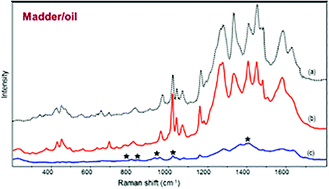Surface-enhanced Raman spectroscopy (SERS) in cultural heritage
Abstract
Surface-enhanced Raman spectroscopy (SERS) has been increasingly used in the last decade for the identification of organic colourants in works of art. ‘Surface-enhancement’ is the giant increase in Raman scattering intensity experienced by organic molecules adsorbed on atomically rough metallic surfaces. In the case of organic colourants, which are in general strongly luminescent under laser excitation and therefore cannot usually be identified by conventional Raman microscopy (see AMCTB no. 67), SERS yields a strong and clearly resolved spectrum, allowing for easy identification. Unlike ordinary Raman spectroscopy, SERS often requires sampling, yet the sample size is considerably smaller (from 20 to 100 micrometres) than that required for high-performance liquid chromatography (HPLC), the benchmark technique for organic colourants analysis. For this reason, SERS has seen substantial use in the analysis of works of art such as prints, drawings, paintings, and polychrome sculpture. This technical brief focuses on the practical aspects of SERS and its application to the analysis of cultural heritage material, as well as on its current limitations.

- This article is part of the themed collection: Analytical Methods Committee Technical Briefs

 Please wait while we load your content...
Please wait while we load your content...